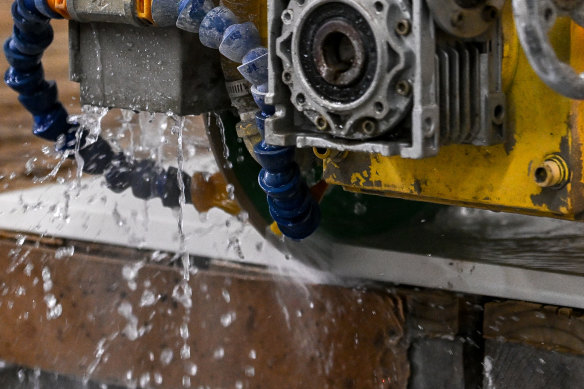
Save articles for later
Add articles to your saved list and come back to them any time.
Engineered stone could be outlawed in future construction if a key recommendation in a long-awaited national review of the products’ dangers is adopted by state and federal governments.
Calls for a blanket ban were taken up on Tuesday by the Australian Council of Trade Unions (ACTU), which vowed to prohibit the material – commonly used for kitchen benchtops – on the nation’s building sites by next July, if state governments had not acted by then.
Governments may stop short of a total ban on engineered stone, commonly used in kitchen benchtops, when they release Safe Work Australia’s report, expected on Friday.Credit: Eddie Jim
Sources with knowledge of the Safe Work Australia report, speaking on background to discuss its contents ahead of public release, said one option put forward was an all-out ban. Unions and health experts say there is no safe level of exposure to the dust generated from cutting engineered stone.
But governments may stop short of a total ban when they release the report, expected on Friday, following lobbying by manufacturers and division among the states.
The ACTU issued its declaration after construction union boss Zach Smith put forward a motion at an executive meeting on Tuesday calling on affiliates to do everything they could to boycott engineered stone.
“Today, the ACTU executive sends a clear message that governments should ban this harmful fashion product,” the union peak body’s assistant secretary, Liam O’Brien, said in a statement.
Smith later revealed that the Construction, Forestry, Maritime, Mining and Energy Union – which is already refusing to handle the substance from next July unless a full ban is imposed – was in talks with major developers over agreements to stop using engineered stone on all new projects. He did not specify which developers were involved.
A joint investigation by The Sydney Morning Herald, The Age and 60 Minutes earlier this year revealed a growing number of workers were battling the debilitating symptoms of lung disease silicosis while state-based regulators failed to effectively police workplaces to guard against the dangers associated with inhaling crystalline silica dust.
A study into silicosis by Curtin University estimates there are more than 275,000 workers – including miners, contractors, construction workers, stonemasons and tunnellers – exposed to high levels of crystalline silica, which is carcinogenic. Commissioned by the ACTU, the study predicts up to 103,000 workers will be diagnosed with silicosis.
In February, Workplace Relations Minister Tony Burke, along with state and territory work, health and safety ministers, commissioned Safe Work Australia to investigate the implications of a ban.
“We can’t keep delaying this. It’s time we considered a ban. I’m not willing to wait around the way people did with asbestos,” Burke said at the time.
The report was handed to the ministers in August but has so far been kept secret. It is expected to be released following a meeting of the ministers on Friday afternoon.
“Federal, state and territory work, health and safety ministers will meet this Friday for initial discussions about the Safe Work Australia silicosis report they commissioned earlier this year,” a spokesman for Burke said.
The spokesman said Burke would ask the meeting to agree to release the report “to inform the public debate as further decisions are made”.
“The Albanese government believes no one should ever contract a terminal illness simply because they’ve turned up to work,” he said.
According to sources, most states and territories wanted the report released weeks ago, but Tasmania was the hold-out.
Queensland Industrial Relations Minister Grace Grace, who has backed a complete ban, said the ministers would “further consider the matter” at Friday’s meeting. Comment has been sought from the NSW, Victorian and Tasmanian governments.
Two key manufacturers are lobbying the government about the threshold that should be imposed for the amount of crystalline silica in engineered stone products.
Caesarstone wants a ban on manufactured stone with a crystalline silica concentration above 40 per cent, while Cosentino says a 10 per cent threshold could be achieved.
The Australian Institute of Occupational Hygienists said a 10 per cent threshold would probably keep silica dust exposure levels to acceptable workplace standards, but supported a blanket ban as products at that level still weren’t “without risk”.
The NSW government submitted to Safe Work’s inquiry that 40 per cent crystalline silica should be the cut-off for the product.
WorkSafe Victoria said its submission, which has not been made public, focused on the state’s current regulations, which include a licensing regime for users, and define engineered stone as containing at least 40 per cent crystalline silica.
Speaking at a dinner hosted by law firm Sparke Helmore earlier this year, Burke warned banning manufactured stone products outright could have unintentional consequences.
“The issue that we will have to weigh up is, we don’t want to create a perverse outcome where we in fact push people to a more dangerous product because we’ve done a ban across the board, if it turns out that some forms of manufacturing stone are, in fact, proven to be safer than natural stone,” he said.
The construction union’s Smith said thousands of union members would demonstrate outside NSW Parliament House on Thursday, urging politicians to ban engineered stone. He said the momentum behind a ban was growing “but we’re not going to sit idly by and wait while more workers die”.
Cut through the noise of federal politics with news, views and expert analysis from Jacqueline Maley. Subscribers can sign up to our weekly Inside Politics newsletter here.
Most Viewed in Politics
From our partners
Source: Read Full Article
